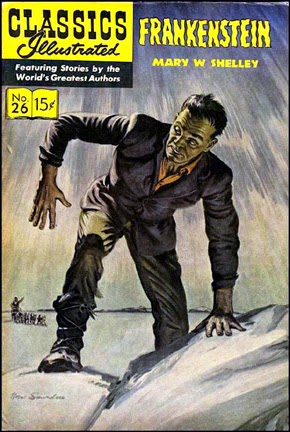 In the 20th century, science fiction became
mainstreamed primarily through SF pulps periodicals in the beginning, outside of
regular novel releases. Monthly
publications presented stories and art to readers often with outrageous covers
and lurid images accompanying the story.
Comic books became another vector for SF most especially through
Classics Illustrated in the 1950s and 1960s.
In the 20th century, science fiction became
mainstreamed primarily through SF pulps periodicals in the beginning, outside of
regular novel releases. Monthly
publications presented stories and art to readers often with outrageous covers
and lurid images accompanying the story.
Comic books became another vector for SF most especially through
Classics Illustrated in the 1950s and 1960s.
 Long before our modern “graphic novels” Classics Illustrated
produced a series of 169 well-known titles from the mundane to the fantastic
with a publication history that ran from 1941 to 1971 for the original
series. They were originally named
Classic Comics Presents for the first five releases and then as Classic Comics
Illustrated for the next two, after which they were dubbed Classics
Illustrated. When the earlier seven
titles were reprinted, they were put under the Classics Illustrated banner
thereafter. They were printed in several countries over the years and in a number of different languages.
Classics Illustrated was a stepping stone from the old-style pulps of the 20s
and 30s and into a newer form at allowed slimmed down version of text stories
with illustrations.
Long before our modern “graphic novels” Classics Illustrated
produced a series of 169 well-known titles from the mundane to the fantastic
with a publication history that ran from 1941 to 1971 for the original
series. They were originally named
Classic Comics Presents for the first five releases and then as Classic Comics
Illustrated for the next two, after which they were dubbed Classics
Illustrated. When the earlier seven
titles were reprinted, they were put under the Classics Illustrated banner
thereafter. They were printed in several countries over the years and in a number of different languages.
Classics Illustrated was a stepping stone from the old-style pulps of the 20s
and 30s and into a newer form at allowed slimmed down version of text stories
with illustrations.
I remember Classics Illustrated fondly, most especially as I
bought them at flea markets when I was looking for more traditional text SF
books in the 1960s. In the days before
computers, used book shops, flea markets, and garage sales were prime places to
hunt books. Few of the old Classics
Illustrated comics I turned up were in mint condition and some clearly had been
read hard and put away wet. Many early
printings in excellent condition can command high prices in the collector’s
market.
Science fiction and horror/weird fiction were well
represented in the repertoire of the Classics Illustrated series with several
classic SF stories. Interestingly, a
good portion of them were stories that were Victorian in origin and more
importantly (for the publisher) many were out of copyright.
Some of the writers represented by Comics Illustrated were
Jules Verne, Edgar Allen Poe, Mary Shelly, and Mark Twain. Alas, there was no Robert E. Howard and no
H. P. Lovecraft, although (surprise surprise) Talbot Mundy’s, King of the
Khyber Rifles #107 and Arthur Conan Doyle’s, A Study in Scarlet #110, Adventures of Sherlock Holmes
#33, and The White Company #102 are in the lineup. Additionally, The Man Who Laughs #71 by Victor Hugo appears, which
was made into an outstanding silent movie* and the basis of the character
of The Joker, makes an appearance in the lineup.
You’ll easily recognize these classic gems of SF, horror and
weird fiction, many of which were made into film, some several times over the
years:
Dr Jekyll and Mr. Hyde #13
Connecticut Yankee in King Arthur’s Court #24
Frankenstein #26
Poe’s Mysteries #40
Twenty Thousand Leagues Under the Sea #47
Around the World in 80 Days #69
The Gold Bug/The Tell Tale Heart/The Cask of Amontillado #84
King Solomon’s Mines #97
War of the Worlds #124
The Time Machine #133
First Men in the Moon #144
Invisible Man #153
Food of the Gods #160
Robur the Conqueror #164
CoastConFan
Footnote
*The Man Who Laughs (1928) a silent firm starring ConradVeidt, is based on the Victor Hugo story from 1869.
Other Links of Interest
List of Classics Illustrated Comic Books http://www.tkinter.smig.net/classicsillustrated/list.htm
For those of you interested in those earlier SF periodicals
check out this Pulps Primer: http://io9.com/5680191/where-did-science-fiction-come-from-a-primer-on-the-pulps and one on the origin of SF pulps: http://www.pulpdom.com/history.html
For those interested in pulps covers of all types, check out
this blog on just this subject: http://pulpcovers.com/
Even more pulps and fanzines http://aok.lib.umbc.edu/specoll/exhibits/scifi/
An archive of pulps, many of which are downloadable https://archive.org/details/pulpmagazinearchive
More pulps downloads
http://www.pulpmags.org/archives_hub.html
Project Gutenberg has the full text versions, in several
formats, of these same stories for download for free: https://www.gutenberg.org/
 |
| No, sorry this is just a spoof cover CI never made one |








I always wanted to see these come back in the modern high-end format, but with different works. Neuromancer, Dandelion Wine, Stranger In A Strange Land, VALIS....
ReplyDeleteI fully agree with you about a modern reissue in high definition. The easiest to tackle would be those works that are out of copyright. Some of those titles would be from H. P. Lovecraft, who is enjoying a resurge in interest. With the Steam Punk crowd, Jules Verne would be a hit as well. Graphic novels are a fantastic way to introduce classic SF to readers. There's a lot of new, young graphic artists out there who could produce these works. Let's get some young blood working on these stories in graphic format. I always thought that the Foundation Trilogy would make a great graphic novel.
ReplyDelete